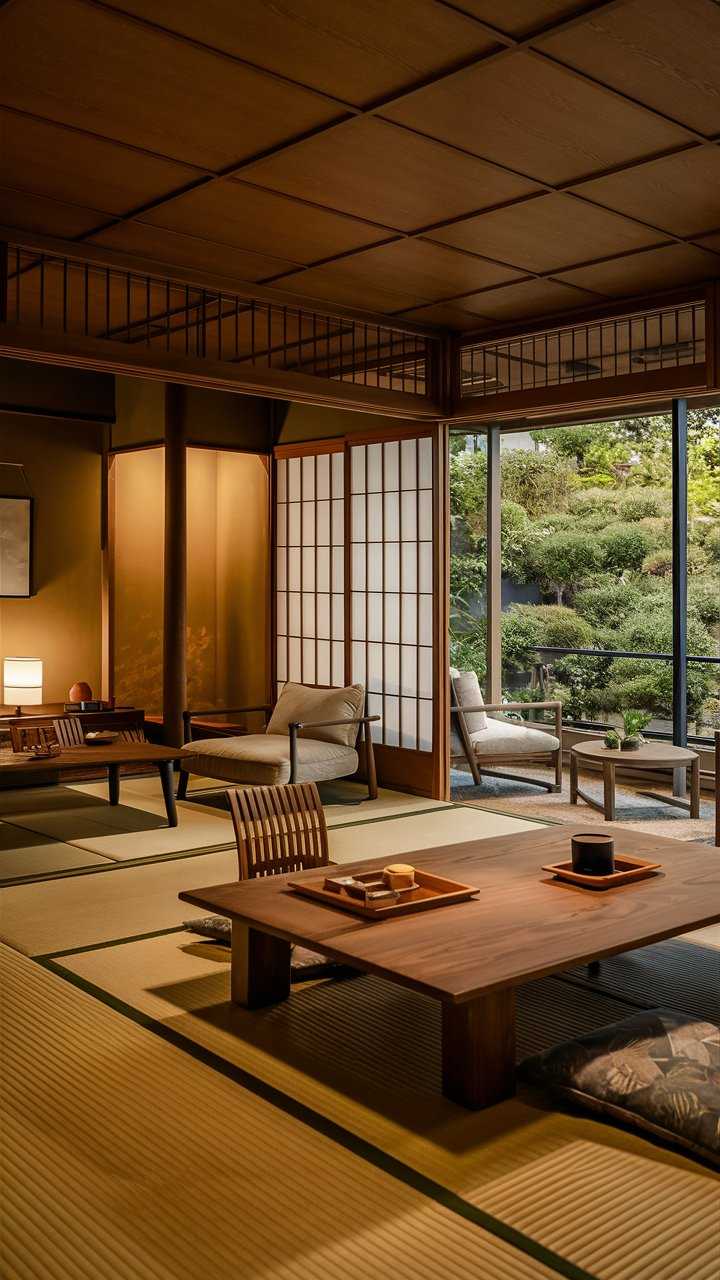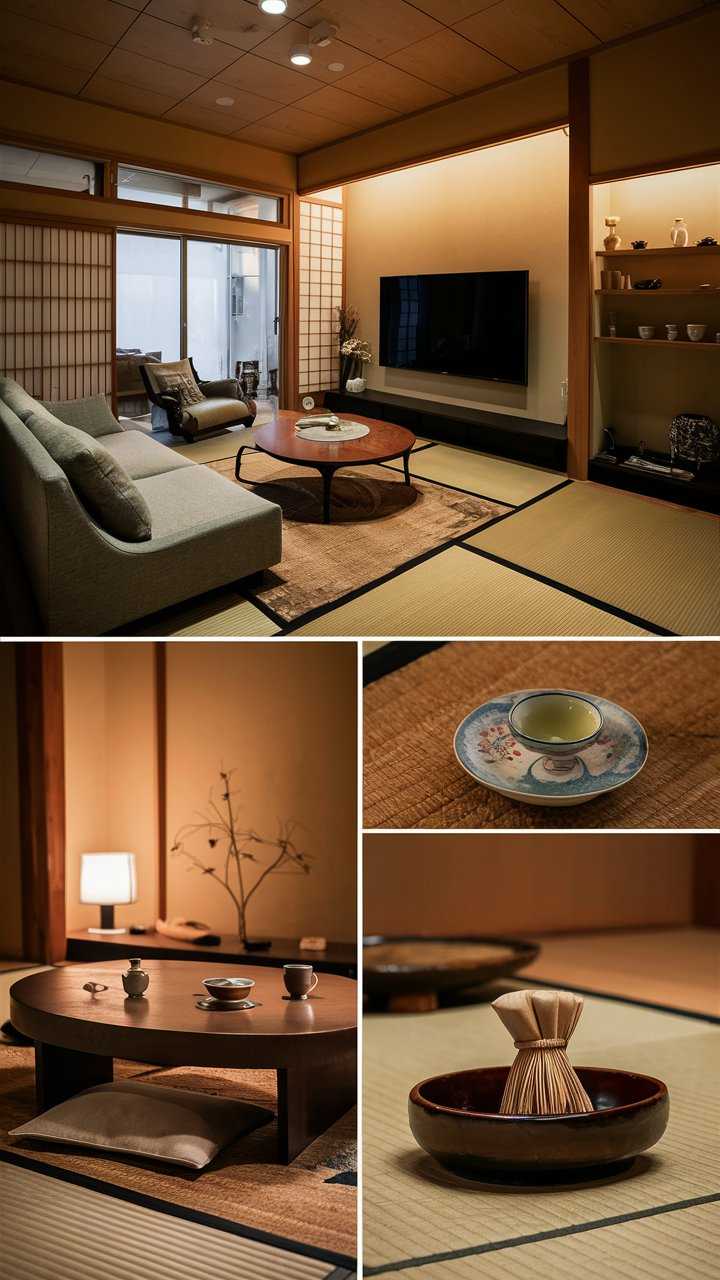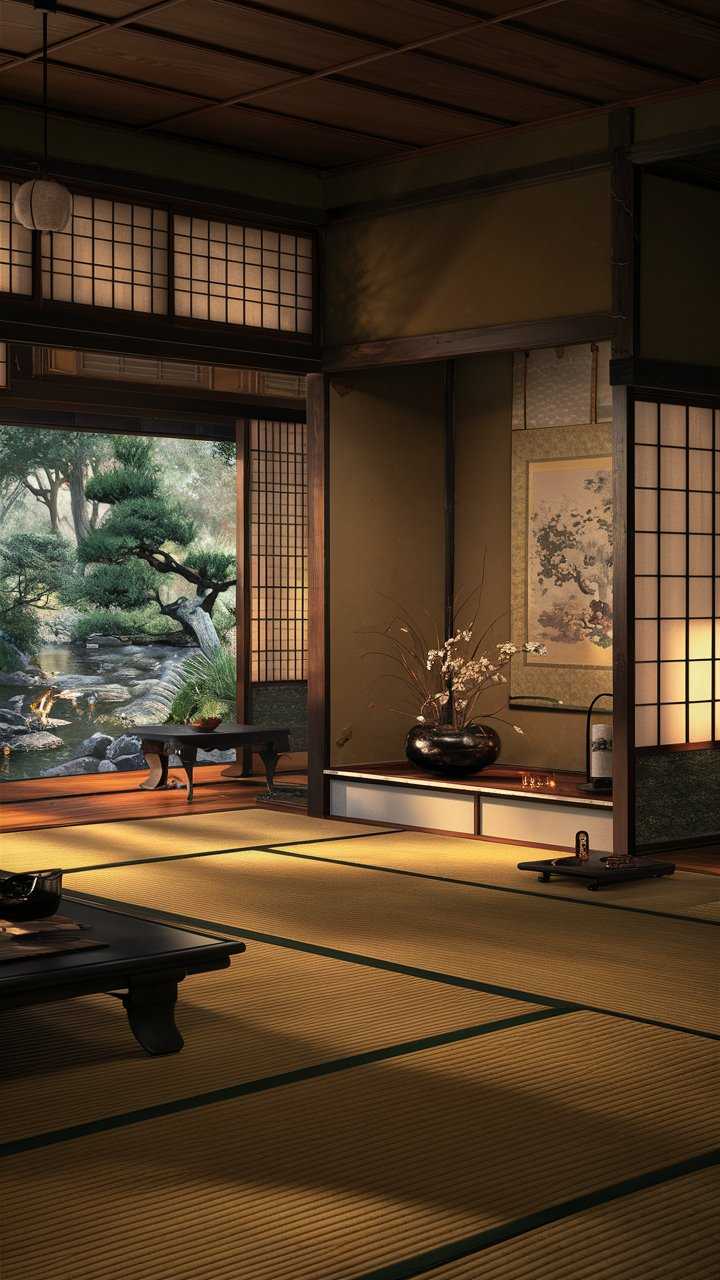Cozy Japanese Living Room Decor Ideas for Your Home
Creating a cozy Japanese living room means blending nature’s beauty with simple design. It’s about making a space that feels peaceful and warm. This kind of decor invites you to relax and find balance at home.
Using natural materials and calming colors helps create a zen feel. This approach makes your living room a place of tranquility. It’s all about simplicity and comfort.
Adding elements that remind you of nature is key. For example, floral watercolor wallpaper can make your room feel like a garden. This idea is inspired by the beauty of nature, as shown here.
Choosing the right furniture, textures, and colors is important. It helps create a peaceful and simple space. This balance is what makes Japanese decor so special.
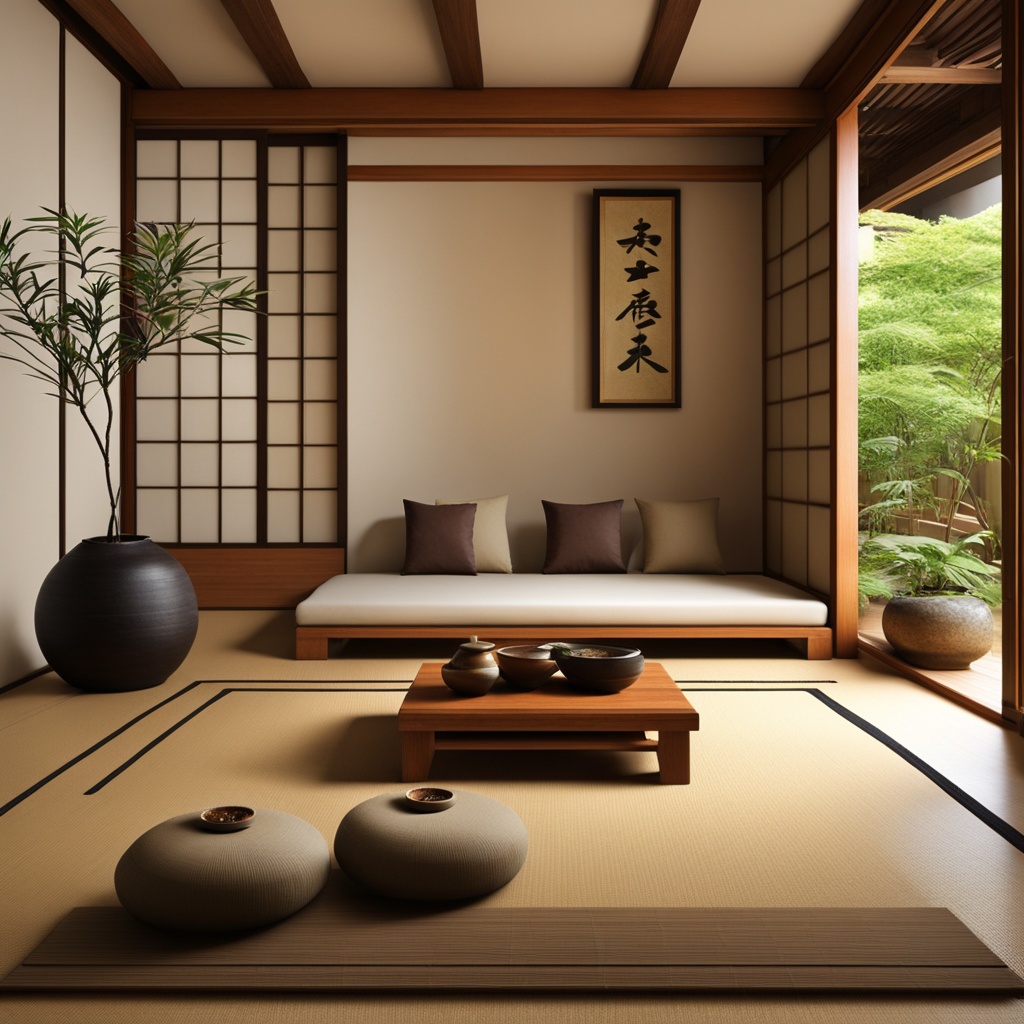
Key Takeaways
- Incorporate natural materials to enhance tranquility.
- Blend minimalist interior design with cozy decor ideas.
- Use calming colors for a zen decor effect.
- Consider floral wallpaper to connect indoor spaces with nature.
- Focus on functionality without sacrificing aesthetics.
Introduction to Japanese Living Room Aesthetics
Japanese aesthetics mix tradition with simplicity in a unique way. They focus on wabi-sabi, which sees beauty in imperfections and things that don’t last forever. This approach helps create a peaceful home by linking us to nature and calming our minds.
Minimalism is key in Japanese design. Every piece of furniture and decor has a purpose. This keeps the space tidy and welcoming. It uses natural materials, soft colors, and light to make the room feel better.
A Japanese living room is all about peace. It has open spaces for easy breathing and finding calm. Making your living space follow these Japanese ideas turns it into a peaceful retreat.
Understanding the Minimalist Approach in Japanese Design
The minimalist approach in Japanese design is all about simplicity and clarity. It’s about removing clutter to focus on what’s truly important. Clean lines and open spaces create a peaceful, mindful environment.
This design style is both beautiful and functional. It makes a home feel calm and improves the overall experience of living there.
Less is More: The Concept of Minimalism
“Less is more” sums up Japanese minimalism. It’s about cutting down on excess to keep only what’s essential. This approach turns spaces into peaceful places where you can think clearly.
With fewer distractions, you can connect more with your surroundings. It’s not just about looking good; it’s about feeling good too.
The Balance Between Functionality and Aesthetics
In Japanese interiors, it’s key to balance function and beauty. Each item is chosen for its use and its look. This way, furniture is both useful and beautiful, showing that simple living can be elegant.
Everything in the space has a purpose. This makes life simpler and keeps the space looking great.
| Design Element | Functionality | Aesthetic Appeal |
|---|---|---|
| Low-Profile Seating | Optimizes Comfort | Enhances visual space |
| Built-in Storage | Reduces Clutter | Seamless integration with decor |
| Sliding Doors | Maximizes Usable Space | Creates a fluid transition between rooms |
| Natural Materials | Promotes Sustainability | Adds warmth and texture |
The Role of Natural Elements in Japanese Decoration
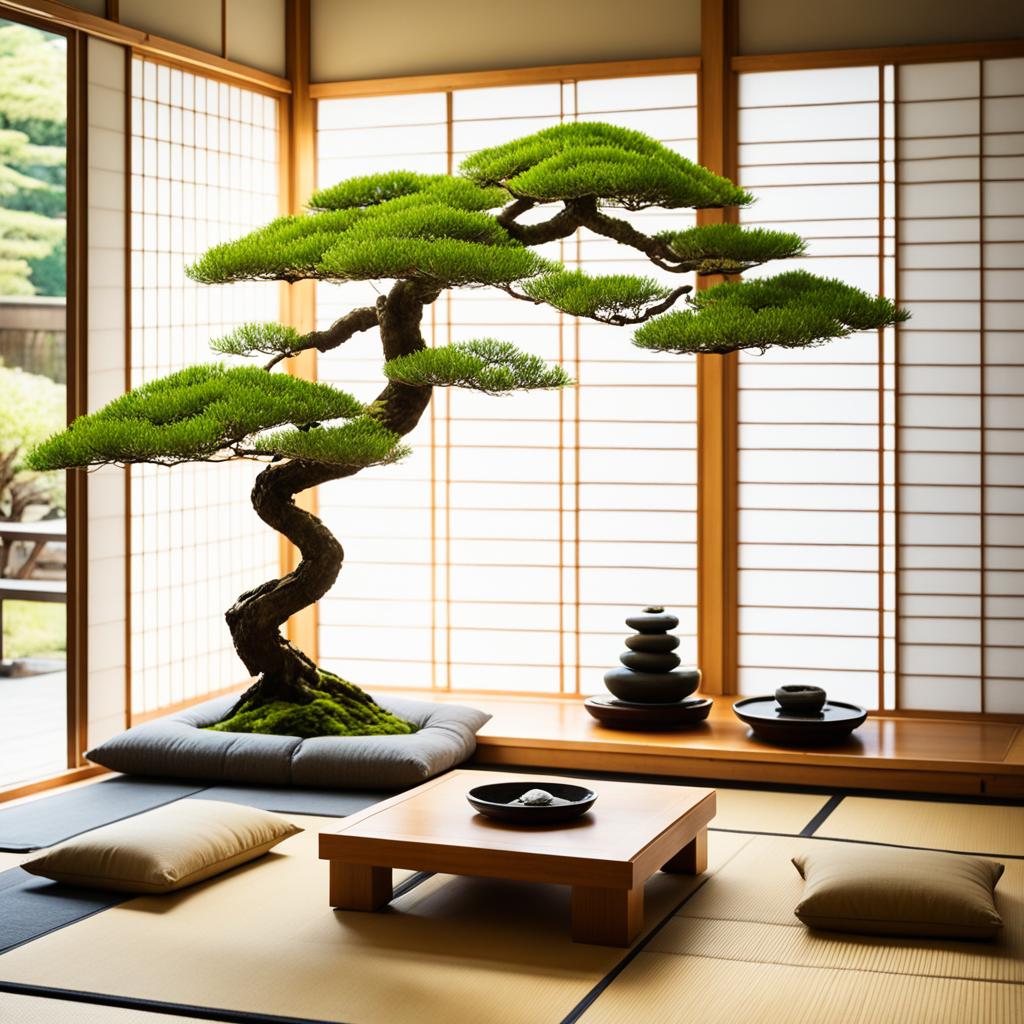
Using natural elements is key to a true Japanese decor look. It means choosing materials that show nature and bring calm. Bamboo furniture and tranquility plants make the space peaceful and serene.
Incorporating Bamboo and Wooden Furniture
Bamboo furniture is a big part of Japanese design. It’s natural beauty and eco-friendliness make it perfect for a simple yet welcoming look. Wooden items keep us connected to nature, adding warmth and texture. They help create a balanced and peaceful space, just like in Japanese design.
Using Natural Plants for Tranquility
Plants are vital for Japanese decor. Bonsai and orchids bring an organic feel to any room. They make the space look better and feel more calm. Adding plants shows the value of nature in our lives and makes the space more relaxing. Use this idea to make your area a peaceful retreat. For more ideas on creating beautiful spaces, check out decor inspiration that goes beyond the usual.
| Type | Material | Benefits |
|---|---|---|
| Bamboo Furniture | Bamboo | Sustainable, lightweight, visually appealing |
| Wooden Furniture | Various Woods | Warmth, durability, natural beauty |
| Tranquility Plants | Bonsai, Orchids | Lively decor, promotes relaxation, connects with nature |
Key Features of Japanese Living Room Decoration
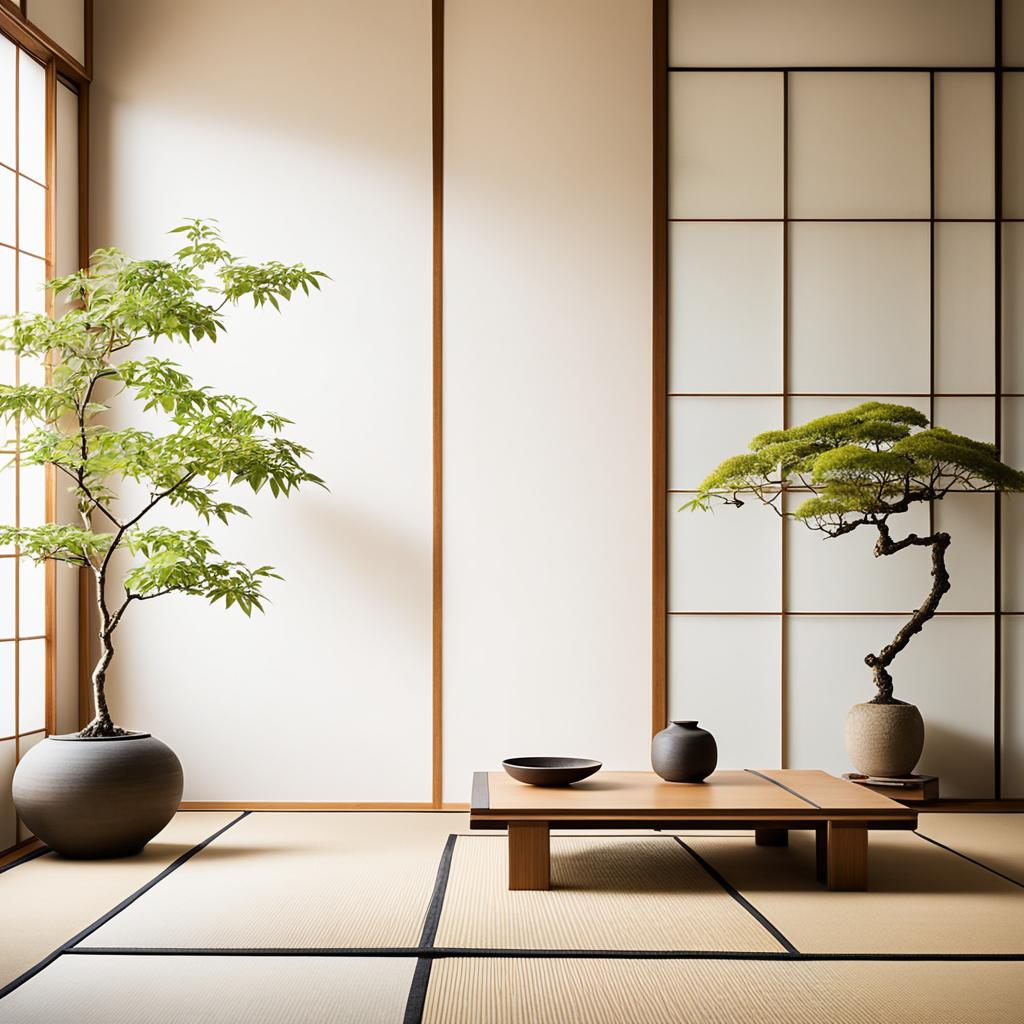
Understanding the key features of a Japanese living room can make it more appealing. This style mixes function with beauty, creating calm spaces for relaxation. Important parts like tatami mats, shoji screens, and a neutral color scheme are key to this look.
Tatami Mats: A Unique Flooring Choice
Tatami mats add a special touch to Japanese homes. They’re made from rice straw and rush grass. These mats are comfy and help control humidity. They also connect people with nature, fitting the peaceful vibe of Japanese design.
Shoji Screens: Functional Room Dividers
Shoji screens are great for dividing rooms while adding art. They’re made of wood and translucent paper. This lets natural light in, making the space feel open yet private. Shoji screens are a beautiful choice for Japanese rooms.
Neutral Color Palette for a Calming Effect
Japanese living rooms often use neutral colors. Soft, earthy tones create a calm feel. This color scheme makes it easy to switch out decor without losing the peaceful look.
| Key Feature | Description | Benefits |
|---|---|---|
| Tatami Mats | Traditional flooring made from rice straw and rush grass | Comfort, humidity regulation, and connection to nature |
| Shoji Screens | Elegant sliding panels for room division | Natural light filtration, privacy, and aesthetic appeal |
| Neutral Color Palette | Soft, earthy colors throughout the space | Calming effect and flexibility in decor updates |
Decorative Elements: Adding Charm to the Living Room
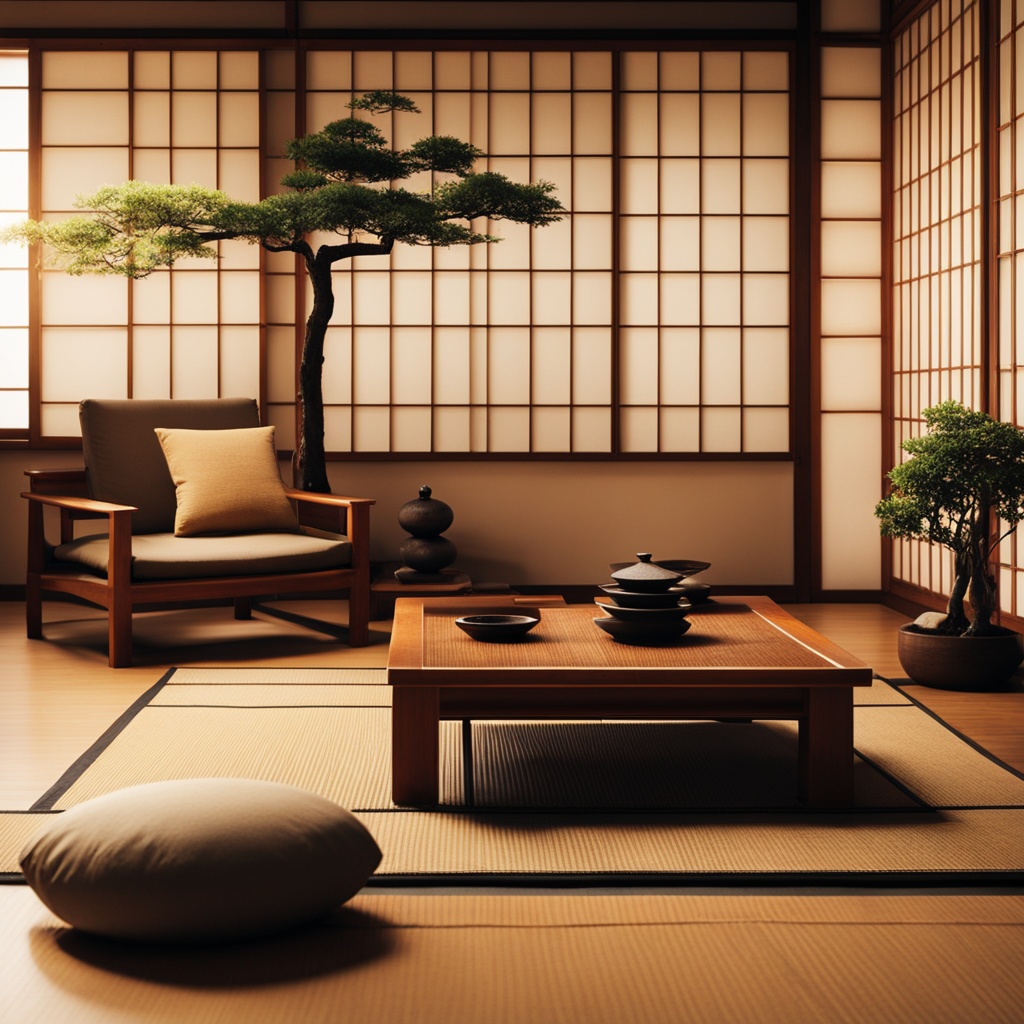
Adding decorative elements to a Japanese living room makes it more charming and peaceful. Things like ikebana arrangements, bonsai trees, and calligraphy art make the space beautiful. They also share cultural stories.
Ikebana Floral Arrangements: An Artful Touch
Ikebana is a special way to arrange flowers, focusing on balance and simplicity. These arrangements use plants in unique ways, showing love for nature. A vase with seasonal flowers can make the living room look better, sparking conversations.
Bonsai Trees: A Piece of Nature Indoors
Bonsai trees bring nature inside. They need special care, showing patience and creativity. A well-kept bonsai tree can make the room peaceful and connect it to the outdoors. It adds a calming touch to the decor.
Japanese Calligraphy Art: Infusing Culture
Calligraphy art adds depth to a Japanese living room. It’s both beautiful and meaningful. Kanji or elegant strokes can show personal values or goals. This art brings tradition and beauty, making it a great topic for guests.
Creating a Zen Atmosphere with Feng Shui Principles
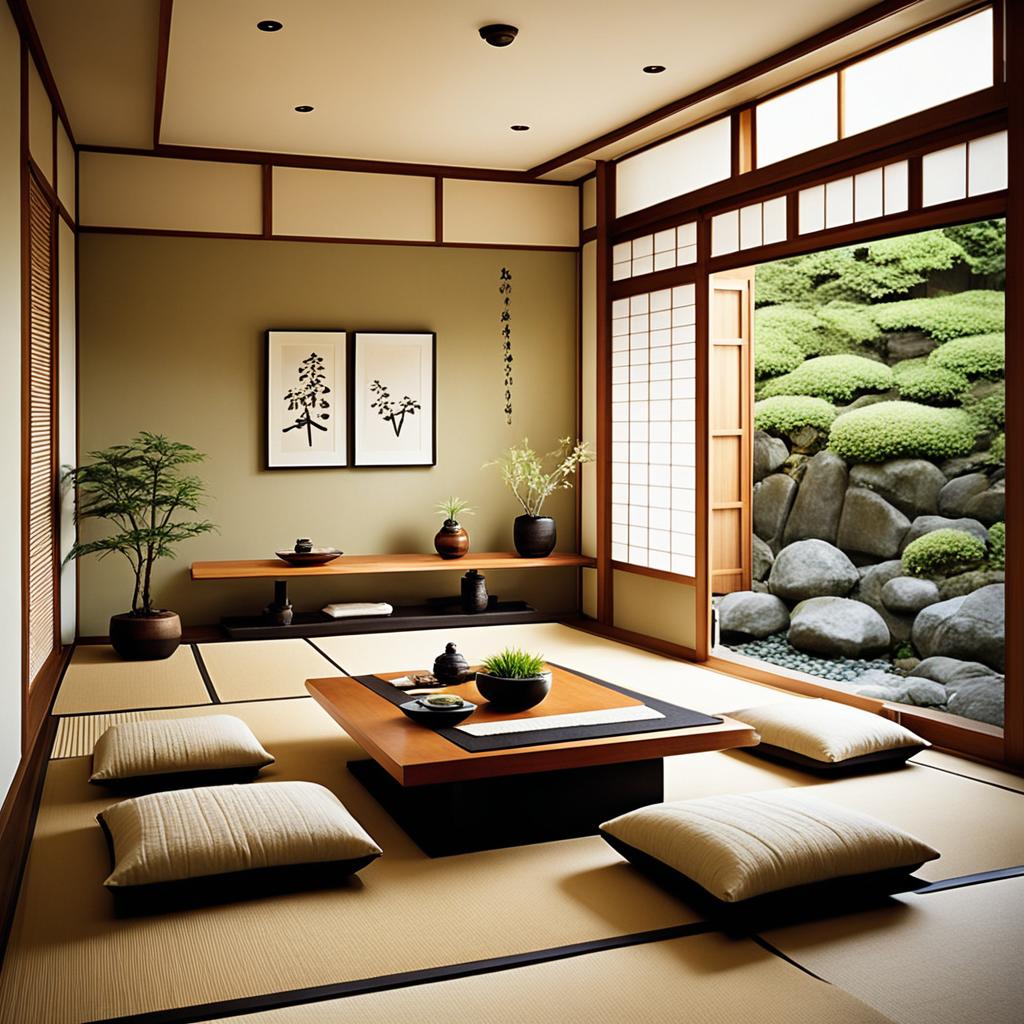
To make your living space zen, use feng shui principles. These focus on balance and harmony. It’s key to understand the importance of space and emptiness. A clean space helps you relax and enjoy your daily life.
The Importance of Space and Emptiness
Space is vital in Japanese design. Empty spaces let energy move freely, making your home welcoming. Leaving areas open helps light and air move around, connecting you to nature. This idea is central to feng shui, which aims to bring positive energy and calm.
Strategic Furniture Arrangement for Flow
Where you place furniture affects the room’s energy flow. A smart layout keeps paths clear and the space open. Placing seats for talking and avoiding blockages helps create a zen feel. Choose furniture that’s low-profile but still comfy and functional.
| Furniture Placement Tips | Description |
|---|---|
| Position seating away from walls | This creates a sense of openness and encourages dialogue. |
| Use low furniture | Maintains the feeling of spaciousness and aligns with Japanese design principles. |
| Incorporate natural elements | Brings the outside in, creating a more relaxed and organic environment. |
| Ensure even distribution of items | Promotes balance and prevents energy stagnation. |
Cozy Furniture Selection for a Japanese Living Room
Creating a Japanese living room means picking furniture that makes you feel relaxed and in tune with the space. Using low-profile seating and traditional items helps create a calm vibe. Each piece is key to making the room both comfy and beautiful.
Low-Profile Seating: Optimizing Comfort
Low-profile seating is a big part of Japanese design. It makes the room look clean and feels comfy. You can use it for chilling out or hanging with friends. Some top picks are:
- Floor cushions
- Low benches
- Futons
These pieces add a chill feel and fit well with the simple look of Japanese rooms.
Using a Kotatsu for Warmth and Relaxation
The kotatsu is a key spot in a Japanese living room when it’s cold. It’s a heated table that brings people together. Adding a kotatsu to your furniture makes your space both useful and meaningful. It turns everyday moments into special times, making your home a cozy place to be.
Lighting Designs that Enhance Serenity
Lighting is key to creating a peaceful space. It can change a room’s look and feel. Using natural light can make a big difference in mood and atmosphere. Also, washi paper lamps add a soft, warm glow, making spaces feel cozy and calm.
Natural Light: Enhancing Mood and Space
Using natural light can boost the mood in a room. Big windows and mirrors help reflect light, making the space feel bigger. Sunlight is good for your mind and helps create a relaxing place. This balance of light and space is important in Japanese design.
Washi Paper Lamps: Soft and Inviting Glow
Washi paper lamps are a beautiful lighting option, giving a Japanese touch. They have a soft, inviting light that improves the room’s feel. The light passing through the paper creates a warm, soothing atmosphere, perfect for a peaceful living room.
Textiles and Patterns to Consider
In a Japanese living room, the choice of textiles and patterns is key. They help create a calm and welcoming space. Using natural materials links the room to nature. Minimalist design adds to the peace.
Choosing the right textiles, like rugs and fabrics, boosts the look and feel of the room.
Natural Fiber Rugs for Comfort
Natural fiber rugs are great for adding warmth and texture to a Japanese room. Made from materials like jute, sisal, or wool, they feel soft underfoot. Their natural look connects the room to the outdoors, which is important in Japanese design.
Choosing Pattern-Free Fabrics for Tranquility
Pattern-free fabrics help create a peaceful atmosphere. Solid colors or subtle textures let the eye rest. This fits well with the Japanese love for simplicity and calm.
These fabrics work well for cushions, throws, or drapes. They add to the room’s peaceful feel.
Enhancing Your Space with Japanese Tradition
Adding elements of japanese tradition to your living room makes it peaceful and culturally deep. A tea ceremony display not only makes the space look beautiful but also brings history and social importance. It shows the beauty of hospitality and mindfulness, adding elegance to your home.
Tea Ceremony Display: Cultural Significance
The tea ceremony is a beautiful part of japanese tradition, turning a simple act into art. Having a special spot for this ceremony lets you show off beautiful tea sets and tools. It teaches us to appreciate the art and thought behind tea, showing a culture that values details deeply.
Incorporating Traditional Japanese Art Pieces
Traditional art can make your living room feel more welcoming and connected to culture. Choose items like ink paintings, kintsugi pottery, or woodblock prints. These pieces show different parts of japanese tradition and make the room feel peaceful. Placing them carefully can start conversations about their stories and where they come from.
| Art Piece | Description | Material | Cultural Significance |
|---|---|---|---|
| Ink Paintings | Subtle landscapes and nature themes | Japanese paper and ink | Reflects harmony with nature |
| Kintsugi Pottery | Repairing pottery with lacquer and gold | Clay and lacquer | Embracing imperfections as beauty |
| Woodblock Prints | Vibrant scenes and historical narratives | Wood and pigment | Captures moments in japanese history |
Conclusion
Embracing the cozy Japanese living room decor can change your home into a peaceful retreat. By using minimalist design ideas, you make a space that is both tranquil and comfortable. Elements like natural materials, warm lighting, and traditional art add to the inviting atmosphere.
This balance of function and beauty in Japanese design creates a relaxing space for daily life. Adding decor like tatami mats, shoji screens, and low-profile seating makes your living room look beautiful and uncluttered. These choices bring nature into your home, offering a calm break from daily life.
By adding these key elements of cozy Japanese living room decor, you create a warm sanctuary. It blends cultural appreciation with modern style. Whether you like the beauty of a bonsai tree or the simplicity of natural textiles, these ideas will make your living space peaceful and stylish.
